Policing of the anti-lockdown protests

Our analysis and concerns arising from the policing of protests in Melbourne – Saturday 18 to Sunday 26 September 2021
Melbourne Activist Legal Support (MALS) has been closely monitoring the policing of anti-lockdown protests since early 2020, particularly the escalation in the policing of the protest events over August and September 2021. MALS has used a combination of direct on-the-ground observation, monitoring of multiple livestreams, analysis of video and media reports, and the use of trusted third-party eye-witness accounts to assess the policing of recent events. We have worked to verify reports, images and footage where their origin is unconfirmed and have sought to correct misinformation about certain images or footage that have been circulating on social media.[1]
Drop down to the Summary and Recommendations
Introduction
There are a range of complex dynamics relating to the policing of these protests that we have noted.
As we have previously made clear, MALS does not support or advocate for the anti-lockdown movement. Many of the diverse elements of the movement espouse destructive conspiracy-theory ideologies, some of which have their origins in far-right and patriot circles in the United States, or are variations of older racist and anti-Semitic tropes. The influence and active involvement of known far-right groups and individuals in the anti-lockdown movement both in Australia and internationally is well researched and documented.[2]
Although people may be drawn to the movement with a range of valid concerns about the social, economic, and other human impacts of lockdowns, or concerns about vaccines and government mandates; the core demands and underpinnings of the anti-lockdown movement remain largely antithetical to human rights, and are more akin to extreme neoliberalism or hyper-individualism. Many people joining the movement may not necessarily be aware of the influence of far-right ideologies and rhetoric. The way that these protests have hijacked human rights terminology and the language of historic civil rights struggles is an ongoing cause of concern. There is nothing new about the far-right using fear and social upheaval to mobilise and build support, but it remains very dangerous.
Notwithstanding this, MALS is concerned about the encouragement of police violence or even calls for greater force to be used against protesters from some sections of the media and community. This creates a very dangerous trajectory and assists in this sort of policing becoming more normalised. Any excessive, unlawful policing, or policing that potentially infringes on human rights should be resoundingly condemned.
Police violence and brutality is counteractive in that it has served to reinforce the movement’s own narrative of perceived ‘tyranny’ and ‘oppression’, which can draw more people toward it. Movement influencers ensure that any real or perceived police overreach is maximised to generate more support for their cause.
One particularly common narrative of the anti-lockdown movement is that oppressive policing in the context of the pandemic is exceptional and unprecedented. This is an easy assumption to make, but in the context of ever-expanding surveillance capitalism and the escalation of militarised policing over the past two decades, the repression of the anti-lockdown movement is not particularly unique, special, or exceptional at all.
The rise of the global justice movement in the late 1990 and early 2000’s saw the introduction of extremely repressive legislation, police powers, and technology that allowed huge areas of major cities to be declared as ‘no-protest zones’, the removal of freedom of association and peaceful assembly rights, the suspension of habeas corpus, extensive surveillance of activists, pre-emptive arrests, and deportations from Australia.
In Melbourne in 2006 during the large protests against the G20 conference several people were picked off the streets by unidentified state agents in unmarked white vans.[3]
The visit of US President George Bush to Sydney in 2007 saw the shut-down of public transport for three days,[4] the closure of major roads[5] and huge areas of the city gazetted, preventing the exercise of basic civil and political rights.[6]
The Spanish Indignados and the later Occupy movements in 2011 experienced extremely repressive policing, including pre-emptive arrests, the use of batons, OC spray, and police dogs, and saw anti-terror resources and equipment being used to repress this nonviolent social movement.
The eviction of Occupy Melbourne from the City Square in October 2011 saw hundreds of injuries from police violence during scenes that were similar to the recent policing at the Shrine Of Remembrance.[7] All of this has been extensively documented by legal observer groups in Australia.
The anti-lockdown movement should not claim its experience of policing is exceptional in this context.
The police tactics and weaponry seen over the past weeks in Melbourne’s CBD may have seemed shocking to the wider Australian public. But they have already been deployed multiple times in Victoria in prison protests, in public housing estates and upon young people of colour during Victoria’s racialised crime panic.
Excessive use of force is disproportionately used at Black-led protests, and overwhelmingly against protesters from historically or systematically marginalised or oppressed groups.[8]
As Sahar Ghumkhor wrote recently, “Australia has seen over 70 counter-terrorism laws introduced since 9/11. Each, pushing the boundaries of state power. I suppose curtailing the freedoms of those with darker skin did not feel like freedom lost for white Australians – it felt like freedom gained.”[9]
The anti-lockdown movement should not claim its experience of policing is exceptional in this context.
The escalation over September
The comparatively large monthly “World Wide Rally for Freedom” events in Melbourne and Sydney on July 24 and August 21, 2021 saw an escalation of police responses including the use of horses, batons, OC spray and the use of projectile weapons. The MALS Statement of Concern[10] raises issues with the use of these weapons. We acknowledged that on many occasions police use of weapons on August 21 took place after several warnings were given by police, and after incidents of flares and projectiles being thrown at police lines.

The protest in Richmond and Kew on Saturday September 18, 2021 marked another turning point. The police decision not to deploy the Public Order Response Team (PORT) with protective gear and weapons at the protest was criticised by The Police Association Victoria (TPAV) and the subject of an internal police review.[11] TPAV Secretary Wayne Gatt reported injuries of 10 police officers including six who were hospitalised and criticised the operational decision not to deploy PORT and anti-riot equipment on the day.
The following day, Victoria Police foreshadowed that PORT would be the first and front-line response at future anti-lockdown protest events. In effect, based upon their assessment and experiences of earlier anti-lockdown protests, police began treating these protests as affrays or unlawful assemblies. Chief Commissioner Shane Patton told the Age that “he would do everything in his power to protect front-line general-duties police from being attacked in confrontations.”[12]
At subsequent protests in the Melbourne CBD on Monday 20, Tuesday 21, and Wednesday 22 September, police deployed the heavily armoured PORT, the Critical Incident Response Team (CIRT) and projectile weapons as a front line response rather than being kept in the rear of police lines as had been the case previously. On several occasions over these three days, police provided warnings and demands to disperse via loudspeaker, and then used a combination of tear-gas and projectile weapons to disperse the protests or used large lines of personal to contain or restrict their movements. Protest groups mostly responded to this by moving away from police, marching through the CBD and inner city and generally attempted to avoid direct clashes with police lines.
On Tuesday 22 September Chief Commissioner Patton said Victoria Police had “significant tactics in place” which will be different to the ones seen yesterday and there would be a heavy police presence. He stated “you have seen that we have a range of crowd control equipment that we’ve already deployed and I have instructed by police commanders if that’s necessary to use, then they are to use it.”[13]
Each use of force event resulted in crowd panic, anger and the protest group moving or marching to another location. At times the protest group split into multiple groups in response to the police use of force and later rejoined at a different location.
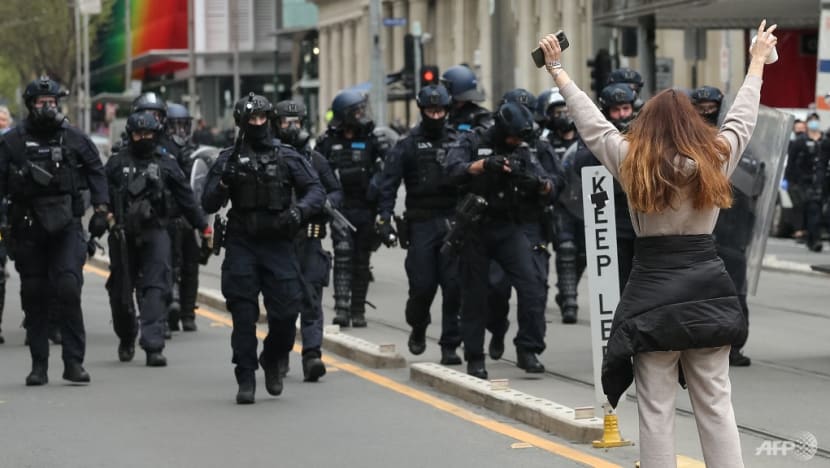
This policing and protest activity culminated on the afternoon of Wednesday 22 September when protesters marched to and occupied the Victorian Shrine of Remembrance on St Kilda Road. The several hundred protesters gathered there and were soon encircled by police. Over several hours police cordoned the protest group, allowing people to leave and waiting for numbers to dwindle. After efforts were made to negotiate a departure and after warnings to disperse were given, police began arresting people, and then firing projectile weapons and tear gas into the crowd as they fled away from the Shrine toward St Kilda Road.
Later protests have been markedly smaller and in various locations outside the CBD but police still responded with large deployments of PORT, the Mounted Unit, CIRT and their associated weaponry to cordon and contain the protests as soon as possible after protesters had gathered.
Police have also been using arrests and the application of large fines. Between Saturday 18 and Sunday 26 September, over 940 people have been arrested and more than 800 public health infringements were issued from publicly available reports. This is on top of the 218 arrests after the Saturday 21 August protest event a month earlier.
Weaponry and repressive technology
Victoria Police Chief Commissioner Shane Patton said on 3AW radio (23 September) that police used “vapour dispersal grenades (strong OC spray), foam baton rounds (hard squash-ball like projectiles) and flexible baton rounds (‘beanbag’ rounds) on the group.”
Explosive devices such as Stinger grenades and flash-bangs should be immediately banned by the Victorian Government due to their documented ability to cause severe injuries.
– Melbourne activist legal support
MALS has noted the use of 12 gauge shot-gun style weapons firing baton rounds, and single and multi gas round launchers.
Capsicum canisters that detonate to release a cloud of capsicum can lead to deaths if people are struck by the canisters or if gas gets trapped in a confined area.[14]
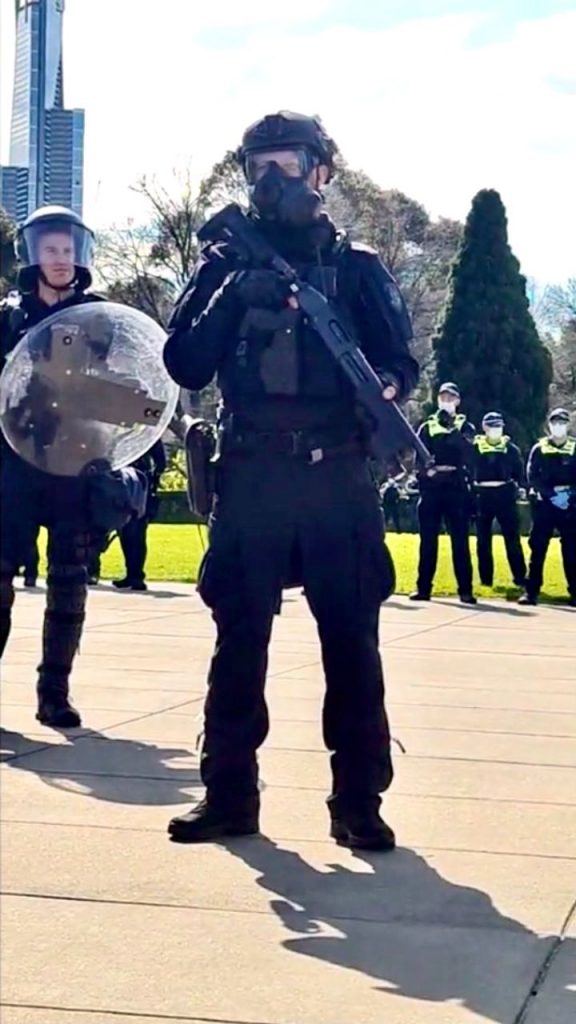
The 40-millimetre rubber bullet launcher has resulted in significant injuries and fatalities around the world.[15]
The VKS ‘Pepperball’ Firearm is a 175 shot semi-automatic rifle that fires capsicum rounds, blunt force pellets the size of marbles or dye markers to brand people for arrest later. These pellets can blind, maim and leave permanent injuries depending where they hit the body.[16]
Stinger grenades are a pain compliance, distraction and disorientation device. It may be thrown or launched in the general direction of the crowd and may be deployed for ground bursts or aerial bursts at the discretion of the operator. It then explodes, releasing nine 32-calibre rubber pellets to waist height with a range of five metres.
The flash/stun/noise distraction grenades designed to shock and disperse crowds are routinely being used in Israel/Palestine and other conflict zones and have maimed children, can burst ear drums, dismembered fingers and hands if reached for prior to exploding and generate dangerous fear and panic in crowds.[17]
These sorts of grenades are indiscriminate in nature and can affect those being targeted by police and bystanders alike. As the proximity of a person or group of people to the explosion increases, so too does the risk of serious injury or death.
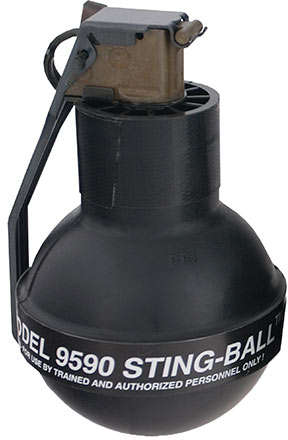
Use in a crowd-control context is often in conjunction with other means of force, including chemical irritants, often leading to panic, with the attendant risk of serious injury. When they explode, grenades can release shrapnel and fragments with sufficient energy to cause serious injury, or even death. The concussive blast of the detonation can cause burns, hearing damage, eye injuries and psychological trauma.[18] Documented injures arising from the use of grenades against protesters include closed cranio-cerebral trauma, acute barotrauma and burns.[19]
Explosive devices such as Stinger grenades and flash-bangs should be immediately banned by the Victorian Government due to their documented ability to cause severe injuries.
MALS asserts that these and other weapons can and have been used unnecessarily, inappropriately, dangerously and in ways that infringe upon human rights.
Deployment or use of anti-riot equipment is not appropriate when protest activity shifts to expressly peaceful forms such as marches, rallies, silent vigils, and should not be used when protesters are sitting, have hands in the air or are moving away from police lines. As further explained below, the tactics of public order policing need to be appropriately staged and proportionate to the behaviour of protest groups.
MALS calls on Victoria Police to immediately roll back from their current front-line deployment of PORT and the use of these weapons.
Injuries as a result of police weapons
Over Monday 20, Tuesday 21, and Wednesday 22 September, there were several incidents where tear gas, OC spray and projectile weapons were used, resulting in several injuries reported by protesters, some of which were documented by media.
We note that in some cases, reverse image searches revealed that some images and videos of injuries shared by protest groups on social media were from older or international incidents. A number of graphic photos allegedly showing wounds suffered by the protesters in Melbourne were found to be unrelated to the Melbourne rallies. Three injury photos widely shared by anti-lockdown movement channels were several years old and had originated in Buenos Aires, Argentina and several US cities including from Black Lives Matter protests. As noted above, we caution that images on social media should be verified before their use as evidence of injuries. [20]
The sharing of some false images does not belie the fact that the police’s use of projectile weapons resulted in a range of physical injuries to protesters, including severe bruising, contusions, abrasions and cuts. The number and severity of injuries over the week are not known and this information has not been compiled by protest groups to our knowledge.
Bearcat armoured personal carrier
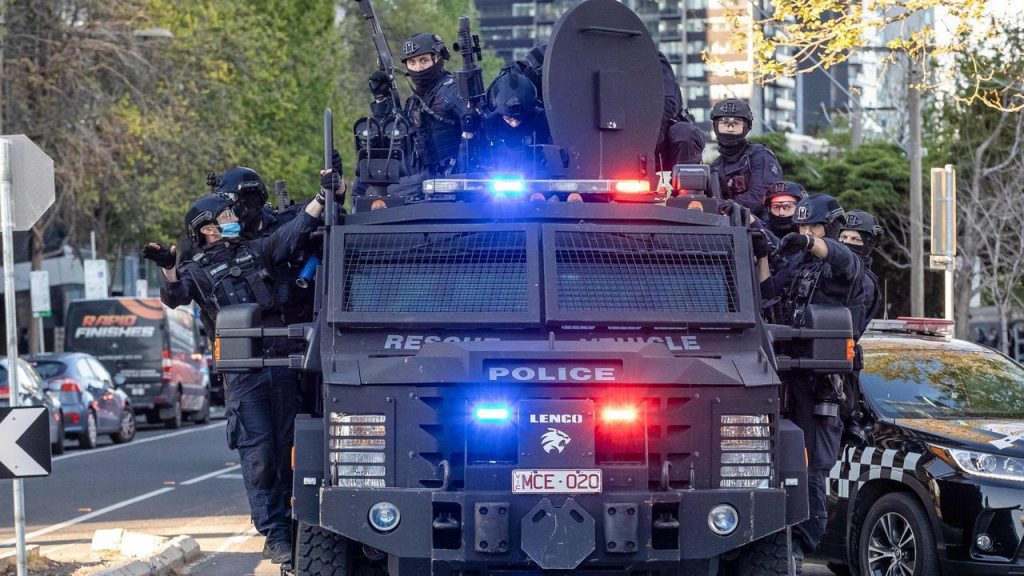
The Lenco BearCat is a US-made armoured personal carrier designed for military and law enforcement use. It is in use by several military forces and law enforcement agencies around the world. The name BearCat stands for Ballistic Engineered Armoured Response Counter Attack Truck. The BearCat is designed to provide protection from a variety of small arms, explosives and IED (Improvised Explosive Device) threats.
It was purchased by Victoria Police in 2013 for use by the Special Operation Group in high-risk incidents including “sieges, counter-terrorism incidents and in catching armed offenders”[21] and has been used in several such incidents since. It was retained by the Critical Incident Response Team (CIRT) in 2018.[22]
The week starting Monday 20 September marked its first use in a protest context and is another concerning example of the militarisation of protest policing.
MALS calls for the armoured Bearcat to be immediately removed from all front-line protest and public order management roles.
Critical Incident Response Team (CIRT)
The presence of CIRT personnel and equipment at these protests is highly unusual and indicates the degree of risk that police perceive at these protests. CIRT have ballistic personal armour and helmets, use balaclavas to conceal their identity and should only be deployed for incidents deemed high risk that involve an armed offender or offenders.
Although there was a media report of a handgun seen at the rear of the CFMEU offices during scuffles on the afternoon of Monday 20 September, this was not verified.[23] We understand that state security agencies including ASIO have been investigating several far-right and neo-Nazi groups in Melbourne who have been involved in organising some anti-lockdown protests and that personal ownership of weapons has been associated with some of these investigations.[24]
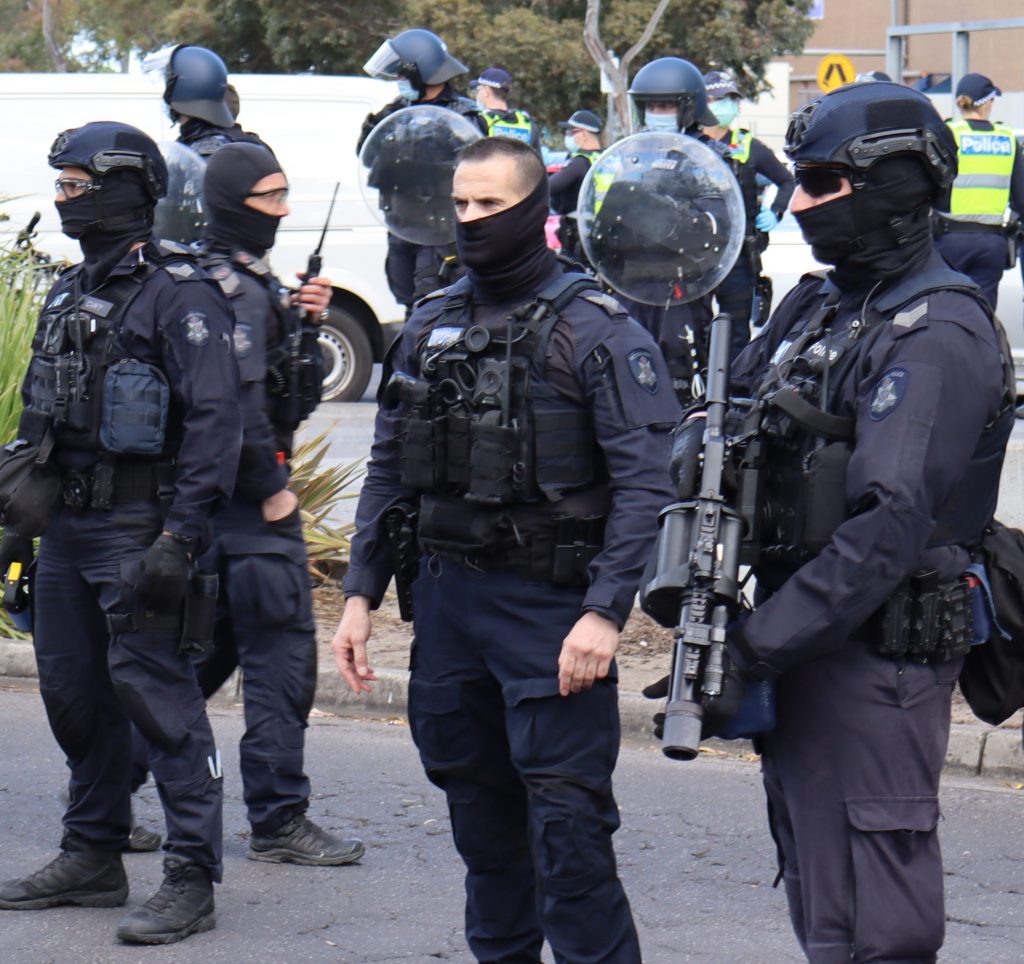
Despite these reports there was no indication that any of the several thousand people involved in the series of anti-lockdown protest events in September were armed. There have been no reports or indications that any of the protest groups have a history of using weapons. No weapons were reported after any of the almost 1000 arrests over September. The throwing of projectiles such as bottles, cans and flares is catered for by the protective gear carried by the PORT. The use of an ‘armed-offender’ resource such as the CIRT is entirely inappropriate in this current context.
The CIRT, in a similar way to the elite Special Operation Group (SOG), has been highly influential on Victoria Police training, culture, operations and tactics, deploying a range of new military-style tactics and weapons as part of their anti-terrorist and armed offender response. CIRT members are considered elite and provide a role model for other police members. Their presence at protests serves to further insert paramilitary attitudes and tactics into public order policing. The CIRT has effectively been used as a testing ground for new weapons including trialing the introduction of tasers, OC spray and ballistic weapons.[25]
There have been numerous controversial and concerning incidents involving CIRT members over recent years. The investigation by the Independent Broad-based Anti-corruption Commission (IBAC) into the conduct of CIRT officers at the Hares & Hyenas bookstore in Fitzroy in May 2019 highlighted a number of concerns with the operation of the team. IBAC has stated that it holds broader concerns regarding “potential systemic issues and misconduct vulnerabilities” in relation to the CIRT and is currently developing a special report on misconduct issues and risks associated with the CIRT.[26]
The use of an ‘armed incident’ and anti-terror asset such as CIRT is entirely inappropriate in the current context of these anti-lockdown protests.
MALS calls for the CIRT to be immediately removed from all front-line protest and public order management roles.
Riot or protest?
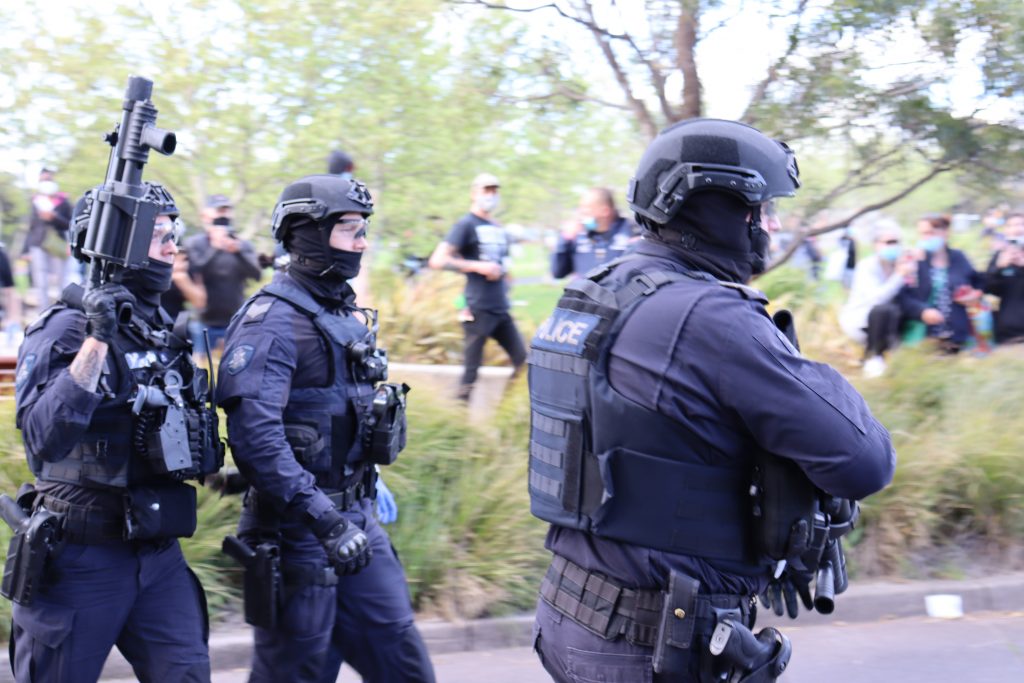
When does a protest become a riot? Well, when the police decide. The terms ‘riot’ and the labelling of protesters as ‘rioters’ have been used extensively since police made the operational decision to place its public order equipment and personnel on the front.
Despite the public commentary, it is the police who operate as the ‘primary definers’ of what is legitimate or unlawful protest and that should be a concern to all.[27]
The term ‘riot’ conjures up images of senseless, unruly behaviour. Central to the understanding of the term ‘riot’ is the concept of collective violence. However, according to Veno and Veno (Police Riots and Public Order, 1989) the definition of situations as being riotous depends upon the police perception of a number of pertinent but subjective factors. These include size, location, crowd demographics and perceived rowdiness, and stereotypes of the group.
The offence of ‘unlawful assembly’ is one of several charges that have been laid against anti-lockdown protesters. MALS has previously written about the use of this archaic charge being outdated.[28] This previously recognised unlawful assembly, rout and riot as escalating levels of offending involving a collective decision to commit unlawful acts.[29] The distinction between each offence was that riot required actual violence; rout involved attempted actual violence; and unlawful assembly supposedly merely required an intention to commit actual violence.
…it is the police who operate as the ‘primary definers’ of what is legitimate or unlawful protest and that should be a concern to all.
In 2017, the offences of riot and rout were abolished under s 195G Crimes Act (Vic), and replaced with the statutory offence of ‘violent disorder’, contained within s 195I of the Act.
Unlawful assembly, however, remains untouched. Common law offences, having no clearly-defined application contained within one legislative source—their definitions instead dispersed across centuries of previous legal judgements—are already ambiguous.
The way in which unlawful assembly is constructed, existing in isolation, provides no meaningful check on the offence being applied in a broad and unfair way. Certain sections of a large demonstration may well have an intent to cause violence, but how would it be fair for this intent to be extrapolated as being the intent of the entire gathering? As interstate and international examples have shown, broad criminal offences that cast a wide net are particularly dangerous in reference to protest and activism. This ambiguity extends to police decisions to use force.
Although some behaviour evident during recent anti-lockdown protests, such as the throwing of projectiles, flares, running through police lines, damaging vehicles, and assaults of police might be characteristics of violent disorder, many other behaviours and tactics employed by the protest groups, such as marches, chants, sitting down and the peaceful occupation of space are characteristics common to peaceful assemblies.
Further, whilst some in a large protest group might be viewed by police as threatening or potentially violent, many, if most of a protest group, may be entirely peaceful and include children, families and those who pose no risk to police.
The fact that it is the police alone who are responsible for defining the ‘common intent’ of groups and the situations in which to deploy high levels of force has been and remains hugely problematic.
Consequently, according to Veno and Veno, police can be accused, rightly or wrongly, of utilising the term ‘riot’ in cases where there is little threat of violence in order to justify inappropriate crowd-control management tactics.
There is actually no clear dividing line between assemblies that are peaceful and those that are violent, and there is very little Victorian jurisprudence (findings of courts) in regards to the limitations on the right to peaceful assembly.[30] However, there is substantial international human rights jurisprudence and precedent which clearly asserts that there is a presumption in favour of considering assemblies as peaceful.[31]
Directions not to gather in public in groups have formed a key plank in COVID laws and policing. This has intensified the power of police to define legitimate protest as well as criminal consequences for participation and organisation.[32]
The Chief Health Officer (CHO) has emergency powers under section 199(2) of the Public Health and Wellbeing Act 2008 to issue orders preventing a serious risk to public health.
COVID-19 public health orders have limited the right to peaceful assembly. While Victoria’s Charter of Human Rights and Responsibilities protects protest rights, these rights may be lawfully limited in a state of emergency. However the CHO directions are largely silent on how restrictions on public gatherings are to be policed.
Victoria Police is still required to act in accordance with human rights under the Victorian Charter of Human Rights and Responsibilities Act (2006) while they are enforcing the CHO’s directions.[33]
Even if an assembly is considered unlawful under the CHO’s Directions, police should not automatically resort to the use of force just because of the fact of its unlawfulness. Only when there are other compelling reasons such as public safety, security or the prevention of crime can police consider resorting to the appropriate use of force.
The individual rights of peaceful participants are not affected by acts of violence by others. The state response to disorder and violence must always be proportionate to the actions taken by the protesters.
ODIHR/Venice Commission, Guidelines on Freedom of Peaceful Assembly
Further, even though a protest is breaking the CHO Direction and therefore not lawful, the assembly should be deemed peaceful as long as the participants remain peaceful, even if the organisers have not complied with all legal requirements prior to the assembly.[34]
In non-pandemic circumstances, breaking the law peacefully during an assembly, for example during civil disobedience or direct action campaigns, is still covered by the right to freedom of peaceful assembly.[35]
The question of whether an assembly ceases to be peaceful must be answered with reference to actual or imminent violence originating from the participants. Violence in this context typically entails the use by participants of physical force that is likely to result in injury or serious physical damage to property.[36]
The right to freedom of assembly is held by each individual participating in an assembly. An individual does not cease to enjoy the right to peaceful assembly as a result of sporadic violence or other punishable acts committed by others in the course of a demonstration if the individual in question remains peaceful in their own intentions or behaviour.[37]
The individual rights of peaceful participants are not affected by acts of violence by others. The state response to disorder and violence must always be proportionate to the actions taken by the protesters.
However, even when participants are not peaceful and, as a result, forfeit their right to peaceful assembly, they retain all the other rights that can be affected by their participation, including but not limited to the rights to due process of law, to bodily integrity, to dignity and to freedom from torture, cruel, inhuman or degrading treatment or punishment.
A large number of factors have to be considered by police before resorting to any use of force, in particular compliance with general use-of-force principles: necessity and proportionality.
The basic principles on the use of force are defined in s462A of the Crimes Act 1958 (Vic) and articulated in the Victorian Police Manual (VPM), but also relevant to the use of force at protests is the UN Code of Conduct for Law Enforcement Officials[38] and the UN Basic Principles on the Use of Force and Firearms by Law Enforcement Officials.[39]
The Code of Conduct lays out the duty of law enforcement officials to “respect and protect human dignity and maintain and uphold the human rights of all persons” and states that “law enforcement officials may use force only when strictly necessary and to the extent required for the performance of their duty”. Exceptional circumstances such as a public emergency may not be invoked to justify any departure from these basic principles.
The ongoing ambiguity of what constitutes and who defines unlawful assembly undermines the Victorian Charter and continues to threaten civil and political rights.
Attempts to shut down aerial media live-streaming
On the afternoon of 22 September , it was reported that Victoria Police had successfully applied to the Civil Aviation Safety Authority to have a three nautical mile no-fly zone declared over the Melbourne CBD until 26 September, with flights below 2500 feet restricted.[40] Victoria Police claimed the no-fly zone was necessary “due to operational and safety reasons in relation to the protest activity”, with protesters allegedly “actively monitoring aerial livestreams, compromising the police operation.”[41]
There was immediate backlash from media companies, with Nine News chief Darren Wick calling it ‘ridiculous’. Within hours, police had scaled back their request and created an exception for media outlets, whilst requiring them to ‘delay publishing any livestream footage from the air by 60 minutes or at the conclusion of the operation’. Pilots were also required to obtain approval from the air wing of Victoria Police prior to take-off, ‘to ensure there are no safety risks.’[42]
The following day, Nine, Seven and the ABC appeared in the Federal Court and were granted a stay to continue the aerial broadcasts, with Justice Helen Rofe finding there was a ‘serious question to be tried on the application.’ The matter is now subject to a formal trial, which is likely to take place in the coming weeks.[43]
Treatment of Journalists
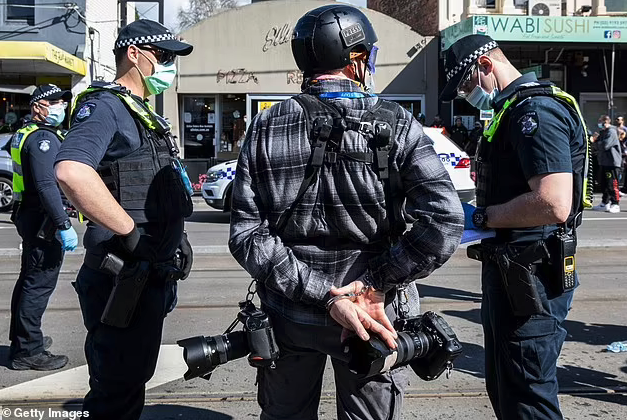
Whilst we are aware of journalists being assaulted, threatened, and verbally abused by protesters during several recent anti-lockdown protests, there were also several disturbing incidents of police assault and abuse against media representatives.
On the afternoon of Saturday 18 September, professional photojournalist and renowned war photographer, Luis Ascui was sprayed directly in the eyes by a police member despite identifying himself as a media representative. We understand this incident is the subject of a formal complaint by The Age newspaper and has been referred to the Professional Standards Command for an internal investigation.[44]
The Media, Entertainment & Arts Alliance (MEAA) has written to Victoria Police to complain about at least four incidents when journalists were manhandled, capsicum sprayed and detained while covering an anti-lockdown protest in Melbourne on Saturday 18 September.[45] MALS has also received reports from other media workers, with formal media accreditation, of being yelled at, pushed and shoved by police members at various times at protest events between Saturday 18 and Sunday 26 September.
“Despite being clearly identifiable as members of the media, some were deliberately targeted by police officers.”
Media entertainment and arts alliance media release .[46]
Media have a right to attend and report on protests, and law enforcement have a responsibility not to prevent or obstruct their work.[47] It is vital that Victoria Police make every effort to identify and differentiate working media from protesters and allow the media to do its job without fear of assault or intimidation.
Public Transport shutdown
Whilst the shutdown of public transport service and traffic checkpoints into Melbourne’s CBD on Saturday 18 September was not particularly unprecedented in Australia, it was a disturbing approach to public order management. MALS agrees with the assessment of the Human Rights Law Centre (HRLC) that these efforts to prevent protest “are concerning both as a response to protest and because of the impact they will have on people who live or need to travel in the area for work or to obtain essential goods or services.” (HRLC 16th September 2021)
We support the HRLC’s call for the Victorian Government and Victoria Police to be transparent around the justification for such extreme measures, the reasons that a planned event is deemed a risk and why less restrictive options cannot be used.
Why was the Black Lives Matter protest not policed in the same way last year?
Anti-lockdown commentators have drawn comparisons between the policing of recent anti-lockdown protest and the markedly different policing of the large Black Lives Matters protests held in June 2020, often claiming it as a form of ‘reverse-discrimination.’ This is disingenuous and wilfully ignores many substantial factors. The Victorian Equal Opportunity and Human Rights Commission (VEOHRC) has aptly addressed this question and we repeat it here.
“The Black Lives Matter protests were held in June 2020, before Victoria went into stage 4 lockdown, and protest organisers undertook to stage the protests in a manner that would comply with the CHO directions in place at the time. In June 2020, Victorians could leave home for any reason but the Stay Safe Directions required people to take reasonable steps to maintain a distance of 1.5 metres from other people and restricted gatherings outside to a maximum of 20 people. Black Lives Matter organisers encouraged protesters not to breach the restrictions and asked people to wear masks, bring hand sanitiser and remain 1.5 metres apart, ensuring distance between each group of 20 people.”[48]
Victorian Equal Opportunity and Human Rights Commission
And as Ghumkhor stated so succinctly, “the BLM protests preserved public health in precarity. The anti-lockdown protests defy public health in privilege.”[49]
Summary and recommendations
Although policing of recent anti-lockdown protests has escalated in response to the behaviour of certain groups of protesters and subsequent injuries of police, any use of force and the deployment of anti-riot personnel, equipment and weapons needs to remain proportional and abide by human rights principles and considerations at all times.
The documented incidents of excessive force and inappropriate use of projectile weapons over the past few weeks, coupled with the extremely high-risk of serious injury, maiming or death as a result of these weapons, means that Victoria Police should immediately limit and roll back their deployment as a front line or first response to protest activity.
Chief Commissioner Shane Patton has told The Age and The Sydney Morning Herald (2 October 2021) that “The community can be assured that when large gatherings are once again permitted, we will happily work with organisers to facilitate peaceful protests.”[50]
This is welcome but, as we await for public gathering restrictions to ease in Victoria, the use of riot police and weaponry against anti-lockdown protests that do not confront or threaten police remains a concern.
Based upon our assessment of policing of the anti-lockdown movement over recent weeks MALS strongly recommends that:
- Victoria Police immediately roll back from their current front-line deployment of the Public Order Response Team and projectile or explosive weapons.
- Victoria Police immediately withdraw the Critical Incident Response Team and the armoured Bearcat vehicle from all front-line protest and public order management roles.
- The Victorian Government immediately legislate to ban the use of explosive devices such as stinger grenades and flash-bangs due to their documented ability to cause severe injuries.
- The Victorian Government and Victoria Police provide transparent justification in the future for any extreme measures such as public transport shutdowns.
Back to the top
References and Resources
Protest Rights in the COVID-19 Pandemic Human Rights Law centre
Say it loud: Protecting Protest in Australia Human Right Law Centre
Explainer: Protests during COVID-19 Victorian Equal Opportunity and Human Rights Commission.
Statement: Melbourne CBD shutdown, Human Rights Law Centre, 16 September 2021
Handbook on Monitoring Freedom of Peaceful Assembly Organization for Security and Co-operation in Europe (2011)
Injuries from Less Lethal Weapons: – Theodore C. Chan, MD, FACEP, Professor of Clinical Medicine, University of California San Diego Medical Center.
Use Of Force Guidelines For Implementation Of The UN Basic Principles On The Use Of Force And Firearms By Law Enforcement Officials. Amnesty International
Policing biosecurity: police enforcement of special measures in New South Wales and Victoria during the COVID-19 pandemic,Current Issues in Criminal Justice, Louise Boon-Kuo, Alec Brodie, Jennifer Keene-McCann, Vicki Sentas & Leanne Weber (2021)
What The Police’s ‘Non Lethal Weapons’ Can Do To Human Bodies, Tara Culp-Ressler, Think Progress (2014)
‘Protest in a Pandemic – The Special Status of Public Spaces’ on AUSPUBLAW Maria O’Sullivan ( July 2020)
Code of Conduct for Law Enforcement Officials OHCHR United Nations
Basic Principles on the Use of Force and Firearms by Law Enforcement Officials. OHCHR United Nations
Far-right influence and involvement in the anti-lockdown movement
A Safe Space to Hate: White Supremacist Mobilisation on Telegram, (Authors, Jakob Guhl and Jacob Davey, Institute for Strategic Dialogue (ISD) June 2020)
Disinformation Overdose: A study of the Crisis of Trust among Vaccine Sceptics and Anti-Vaxxers (Authors: Hannah Winter, Lea Gerster, Joschua Helmer & Till Baaken Institute for Strategic Dialogue (ISD) 6 July 2021)
The antisemitic underbelly of Australia’s anti-lockdown groups (Plus61J Media, September 2021)
Worldwide Anti-Lockdown Protests Organized by German Cell (Logically, May 2021)
Political ambitions and anti-lockdown protests: How neo-Nazis seek to spread influence, (The Age, August 2021)
Who’s behind Australia’s anti-lockdown protests? The German conspiracy group driving marches (The Guardian, July 2021)
Where ‘freedom’ meets the far right: the hate messages infiltrating Australian anti-lockdown protests (The Guardian, March 2021)
‘Reopen’ protest movement created, boosted by fake grassroots tactics (The Conversation, April 2020)
Australia’s Security Environment and Outlook (Australian Security Intelligence Organisation, ASIO 2021)
Australia’s lockdown demonstrations show how quickly local protests can go global, (Australian Strategic Policy Institute , ASPI August 2021)
EndNotes
[1] See, for example, @Activistlegal tweet dated 12 October 2021 at 11.33pm highlighting that photos purporting to reflect injuries from Victoria Police in Melbourne in fact originated from other countries.
[2] A select number of investigative reports and analysis is included in the references at the end of this article.
[3] Federation of Community Legal Centres (Vic) Inc., “Human Rights Observer Team Final Report: G20 Protests” 2007, https://mals.au/files/hrofinalreportforwebrelease.pdf
[4] Tadros, Edmund. “City stations close during APEC”. Sydney Morning Herald, 17 May 2007, https://www.smh.com.au/national/city-stations-to-close-during-apec-20070517-gdq5h0.html
[5] “NSW Govt reveals more details about APEC road closures, no-go zones”, ABC News, 16 August 2007, https://www.abc.net.au/news/2007-08-16/nsw-govt-reveals-more-details-about-apec-road/641774
[6] Benns, Matthew. “Jailed for jaywalking” Sydney Morning Herald, 9 September 2007, https://www.smh.com.au/national/jailed-for-jaywalking-20070909-gdr2e3.html; Smith, Alexandra, et al. “Five more activists added to blacklist”, Sydney Morning Herald, 5 September 2007, https://www.smh.com.au/national/five-more-activists-added-to-blacklist-20070905-gdr17s.html.
[7] Dehm Julia & Dehm, Sarah, “Occupy Policing: The Eviction of Occupy Melbourne”, 1 December 2014, https://mals.au/2014/12/01/occupy-policing-the-eviction-of-occupy-melbourne/
[8] Seedeen, Rashad, “Death by design: Systemic racism and police brutality in the U.S. and Australia” Independent Australia, 20 April 2021 https://independentaustralia.net/politics/politics-display/death-by-design-a-history-of-systemic-racism-and-brutality-in-the-us-and-australia,15004
[9] Ghumkhor, Sahar. “Pandemic policing in ‘multicultural’ Australia”. Al Jazeera, 4 October 2021, https://www.aljazeera.com/opinions/2021/10/4/pandemic-policing-in-multicultural-australia
[10] Melbourne Activist Legal Support. “Statement of Concern: Police use of projectile weapons”. 22 August 2021, https://mals.au/2021/08/22/statement-of-concern-police-use-of-projectile-weapons/
[11] “3AW – TPAV SECRETARY WAYNE GATT ON VIOLENT ANTI LOCKDOWN PROTESTS”. The Police Association Victoria, 19 September 2021, https://www.tpav.org.au/news/news-coverage/2021-news-coverage/3aw—tpav-secretary-wayne-gatt-on-violent-anti-lockdown-protests
[12] Silvester, John. “Riot police set for front line at future COVID protests”, The Age, 20 September 2021, https://www.theage.com.au/national/victoria/riot-police-set-for-front-line-at-future-covid-protests-20210919-p58sz3.html
[13] The Australian, “Now is not the time to protest in Melbourne” 22 September 2021, https://www.theaustralian.com.au/news/now-is-not-the-time-to-protest-in-melbourne/video/1840712ca428086afe492b2451fa1a50
[14] Haar, Rohini et al. “Health impacts of chemical irritants used for crowd control: a systematic review of the injuries and deaths caused by tear gas and pepper spray”. BMC Public Health, 19 October 2017, https://www.ncbi.nlm.nih.gov/pmc/articles/PMC5649076/.
[15] Chauvin A et al (2019) ‘Ocular injuries caused by less-lethal weapons in France’ Lancet 394, https://www.thelancet.com/journals/lancet/article/PIIS0140-6736(19)31807-0/fulltext; Lartizien R et al. (2019) ’Yellow vests protests: facial injuries from rubber bullets’, Lancet 394, https://www.thelancet.com/journals/lancet/article/PIIS0140-6736(19)31764-7/fulltext; Vandoorne, Saskya. “At least 24 Yellow Vests lost eyes in violent protests. Now they’re more determined than ever”, CNN, 14 July 2019, https://edition.cnn.com/2019/07/14/europe/france-bastille-day-injured-yellow-vests-intl/index.html
[16] Ifantides, Christos. “Less-Lethal Weapons Resulting in Ophthalmic Injuries: A Review and Recent Example of Eye Trauma”, 5 August 2021, https://www.ncbi.nlm.nih.gov/pmc/articles/PMC7406611/
[17] Haar RJ et al. (2017) ‘Death, injury and disability from kinetic impact projectiles in crowd-control settings: a systematic review’ BMJ Open.
[18] Physicians for Human Rights and the International Network of Civil Liberties Organizations (INCLO), Lethal in Disguise: The Health Consequences of Crowd-Control Weapons, op. cit., note 10, pp. 66-68.
[19] CPT, “Report to the Moldovan Government on the Visit to Moldova Carried out by the European Committee for the Prevention of Torture and Inhuman or Degrading Treatment or Punishment (CPT) from 27 to 31 July 2009”, CPT/Inf (2009) 37, para. 13, https://www.refworld.org/docid/4ee23cc72.html
[20] A number of graphic photos allegedly showing wounds suffered by the protesters in Melbourne were found by reverse image searches conducted by MALS to be unrelated to the Melbourne rallies. Three injury photos widely shared by anti-lockdown movement channels were several years old and had originated in Buenos Aires, Argentina and several US cities.
[21] ABC News, “‘BearCat’ to assist police in hostile situations”, 12 April 2013, https://www.abc.net.au/news/2013-04-12/27bearcat27-to-assist-police-in-hostile-situations/4625256
[22] Herald Sun, “Victoria Police Special Operations Group gets new BearCat armoured vehicles”, 28 July 2018, https://www.heraldsun.com.au/news/law-order/victoria-police-special-operations-group-gets-new-bearcat-armoured-vehicles/news-story/21325f268c77733bbe42ac4dd6de2710
[23] Schneiders, Ben & Sakkal, Paul. “Construction industry to be shut down for two weeks after clashes at CFMEU”, The Age, 20 September 2021, https://www.theage.com.au/national/victoria/crisis-meetings-after-construction-workers-clash-at-cfmeu-headquarters-20210920-p58t96.html
[24] Australian Security Intelligence Organisation (ASIO). “Australia’s Security Environment and Outlook”, 2019-2020 Annual Report, https://www.asio.gov.au/australias-security-environment-and-outlook.html; McKenzie, Nick & Tozer, Joel. “Inside Racism HQ: How home-grown neo-Nazis are plotting a white revolution”, The Age, 16 August 2021, https://www.theage.com.au/national/inside-racism-hq-how-home-grown-neo-nazis-are-plotting-a-white-revolution-20210812-p58i3x.html
[25] McCulloch Jude, “Keeping the peace or keeping people down? Policing in Victoria”, paper presented at the History of Crime, Policing and Punishment Conference, 9-10 December 1999
[26] IBAC, Investigation summary – Operation Lynd, 21 July 2020 https://www.ibac.vic.gov.au/publications-and-resources/article/investigation-summary—operation-lynd
[27] McNamara, L., & Quilter, J. (2019). Criminalising protest through the expansion of police ‘move-on’ powers: A case study from Australia. International Journal of Law, Crime and Justice, 58, 22–34; Sentas, V., & Grewcock, M. (2018). Criminal law as police power: Serious crime, unsafe protest and risks to public safety. International Journal for Crime, Justice and Social Democracy, 7(3), 75–90.
[28] Melbourne Activist Legal Support, “Unlawful Assembly”, 3 August 2020, https://mals.au/2020/08/03/unlawful-assembly/
[29] Doogue + George Defence Lawyers, “Unlawful Assembly”, https://www.criminal-lawyers.com.au/offences/unlawful-assembly
[30] Judicial College of Victoria, Charter of Human Rights Bench Book. https://www.judicialcollege.vic.edu.au/eManuals/CHRBB/index.htm#57375.htm
[31] European Court of Human Rights, Lashmankin and others v. Russia (applications Nos. 57818/09 and 14 others), Judgment of 7 February 2017, para 402–403, https://hudoc.echr.coe.int/rus?i=001-170857; UN Human Rights Council, “Report of the Special Rapporteur on the Rights to Freedom of Peaceful Assembly and of Association, Maina Kiai”, 14 April 2014, para 26, https://www.ohchr.org/en/hrbodies/hrc/regularsessions/session26/documents/a_hrc_26_29_eng.doc; Organization for Security and Co-operation in Europe, “Guidelines on Freedom of Peaceful Assembly”, 25 October 2010, Principle 2.1, https://www.osce.org/odihr/73405
[32] Boon-Kuo, Louise, et al. “Policing biosecurity: police enforcement of special measures in New South Wales and Victoria during the COVID-19 pandemic”, Current Issues in Criminal Justice, 33(1) 2001, 76-88, https://www.tandfonline.com/doi/full/10.1080/10345329.2020.1850144
[33] Victorian Charter of Human Rights and Responsibilities Act 2006 (Vic) s 16
[34] European Court of Human Rights, Oya Ataman v. Turkey, (Application no. 74552/01), Judgement of 5 December 2006, note 53, https://hudoc.echr.coe.int/fre#{%22itemid%22:[%22001-78330%22]}
[35] European Court of Human Rights, Frumkin v. Russia (No. 74568/12), 5 January 2016, para. 97.
[36] ODIHR/Venice Commission, Guidelines on Freedom of Peaceful Assembly, op. cit., note 8, paras.26–27.
[37] European Court of Human Rights, Ziliberberg v. Moldova (no. 61821/00), 4 May 2004, https://hudoc.echr.coe.int/eng#{%22itemid%22:[%22001-23889%22]}; See also above n 20, para 25.
[38] United Nations. “Code of Conduct for Law Enforcement Officials”, 17 December 1979, https://www.ohchr.org/en/professionalinterest/pages/lawenforcementofficials.aspx
[39] United Nations. “Basic Principles on the Use of Force and Firearms by Law Enforcement Officials”, 27 August 1990, https://www.ohchr.org/en/professionalinterest/pages/useofforceandfirearms.aspx
[40] Koob, Simone & Carey, Adam. “Protest coverage delayed under tightened rules on Melbourne airspace”, The Age, 22 September 2021, https://www.theage.com.au/national/victoria/protest-coverage-delayed-under-tightened-rules-on-melbourne-airspace-20210922-p58txs.html
[41] Nilsson, Anton & McLeod, Catie. “Victoria Police backflip on decision to restrict airspace over Melbourne vaccine protests”, Nationwide News, 22 September 2021, https://www.news.com.au/national/victoria/news/victoria-police-granted-restricted-airspace-over-melbourne-as-protests-continue/news-story/f72cf9af50bc94fc31989e269f55f535
[42] Preiss, Benjamin. “Media companies successfully challenge ba on aerial protest telecasts”, The Age, 23 September 2021, https://www.theage.com.au/national/victoria/media-companies-successfully-challenge-live-broadcast-ban-20210923-p58u2v.html
[43] Argoon, Ashley et al. “Media organisations win right to film protests after police bid fails”, The Herald Sun, 23 September 2021, https://www.heraldsun.com.au/truecrimeaustralia/police-courts-victoria/embarrassing-backflip-after-no-fly-zone-censorship-claim/news-story/f9f32c53597a3b4d439df1c2b6a262a9
[44] McMillan, Ashley. “Age photographer capsicum sprayed by police during protest”, The Age, 19 September 2021, https://www.theage.com.au/national/victoria/age-photographer-capsicum-sprayed-by-police-during-protest-20210919-p58sx7.html
[45] MEAA Media Release. “Media union condemns targeting of journalists by police and protesters’ 22 September 2021, https://www.meaa.org/mediaroom/media-union-condemns-targeting-of-journalists-by-police-and-protesters/
[46] Above.
[47] OSCE Representative on Freedom of the Media, “Special Report on Handling of the Media during Political Demonstrations: Observations and Recommendations”, 18 June 2007, https://www.osce.org/fom/25744
[48] Victorian Equal Opportunity & Human Rights Commission. “Explainer: Protests during COVID-19”, September 2021, https://www.humanrights.vic.gov.au/resources/explainer-protests-during-covid-19/
[50] Le Grand, Chip. “Freedom, interrupted: Will the liberties we lost to COVID be regained?”, The Age, 2 October 2021, https://www.theage.com.au/national/freedom-interrupted-will-the-liberties-we-lost-to-covid-be-regained-20211001-p58wce.html